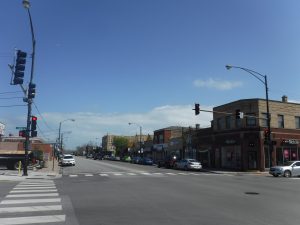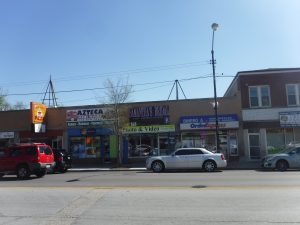Chicago’s East Side Neighborhood looks out for its own
By Igor Studenkov For Chronicle Media — May 9, 2017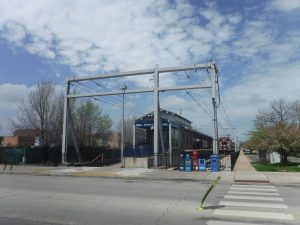
Many East Side residents catch the Metra Electric Line train downtown at 93rd/South Chicago station. (Photo by Igor Studenkov/for Chronicle Media)
Martha Vasquez-Weber, executive director of the East Side Chamber of Commerce, described her neighborhood as an island.
In a sense, that is true. The Calumet River separates the East Side from the rest of Chicago to the north and the west. To the south, the transitionally industrial area lies between it and Hegewisch, a neighborhood in the southeast corner of the city. And the Illinois/Indiana border forms a clear dividing line to the east. Just as many people don’t realize Chicago has a port in the nearby Lake Calumet, many Chicagoans don’t realize the East Side even exists.
As Vasquez-Weber sees it, this helps the community, since it makes East Side residents more invested in their local businesses. While most of Chicago may not know about it, it gets customers from nearby neighborhoods. But the location also comes with its own challenges. The proximity to Indiana means that residents have cheaper place to buy things like gas and cigarettes right next door, and there is not much her organization could do about that.
East Side is one of the several working-class neighborhoods that formed in the Lake Calumet region. According to Chicago History Museum’s Encyclopedia of Chicago, the lake made for a natural port. A network of railroads formed around it, and factories and steel mills set up to take advantage. Republic Steel in particular was a major employer, as was what would eventually became known as U.S. Steel’s Southworks plant, which set up shop in South Chicago neighborhood, directly north of the spot where Calumet River drained into Lake Michigan.
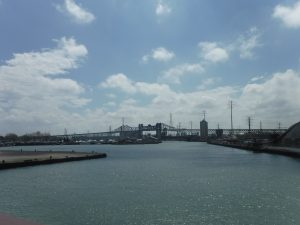
Calumet River separates the East Side from the rest of Chicago. (Photo by Igor Studenkov/for Chronicle Media)
As the 20th century continued, East Side saw a number of labor disputes. Most notably, in 1937, Steel Workers Organizing Committee set out to unionize Republic Steel workers. As part of the campaign, it organized a Memorial Day march on the plant — only to face Chicago police officers, who ordered them to retreat. The marchers complied, but the officers shot anyway, killing 10. The event set back — but didn’t stop — the effort, and the workers were able to unionize in 1941.
In the 1980s, steel mill closures sent shockwaves through communities in the Calumet region in the nearby Indiana, and East Side was no exception. Vasquez-Weber told the Chronicle that, while the job losses hurt her neighborhood, she said it hasn’t affected it as badly as the Southworks shutdown affected South Chicago. She noted that many residents found job opportunities elsewhere.
“We have professionals, a lot of doctors, a lot of attorneys that grew up in the area and were educated in the area,” Vasquez-Weber said. “On the South Shore [branch of the Metra Electric line] — every day, you see nothing but people in suits.”
As she explained it, the loyalty to East Side tends to be strong. It was something Vasquez-Weber knew first-hand.
“As someone who grew up in this area, I absolutely love this area,” she said. “Everybody knows everybody. It’s like a suburb in the city.”
Vasquez-Weber believes that this closeness helps to create a sense of community identity, which helps local businesses.
“A lot of the businesses that are still in the area are mom-and-pop stores,” she said. “We want them to flourish, we want them to become more prominent. The community really stepped up a notch, and they are really supportive. They want to continue to keep this area a safe, flourishing community. They are committed to purchasing in the area.”
Vasquez-Weber noted that East Side has a number of clothing stores, eateries, restaurants and grocery stores, so residents can get many things they need without leaving the neighborhood.
A recent visit to the East Side revealed that commercial corridors that have been around for decades still endure. Ewing Avenue is a major corridor, especially south of the Chicago Skyway toll road, and so is 106th Street. Vasquez-Weber described the intersection between the two as the East Side’s “downtown.” Indianapolis Avenue is mostly home to auto repair shops, but it also has a few newer businesses, including a discount furniture store and a concealed carry firearms training facility. Indianapolis Avenue and 106th Street converge near the Illinois/Indiana border, and several eateries, a bar and the neighborhood Aldi branch take advantage of the traffic.
Vasquez-Weber said that, while most of the customers come from the neighborhood, they also get customers from Hegewisch and South Chicago, adding that she has seen “a lot of people” coming from the later in particular.
She also highlighted several advantages of living on the East Side. While the neighborhood had some issues with crime, the rates are low. The South Shore branch ends in South Chicago, within walking distance of the 92nd Street bridge — one of the few connections between East Side and the rest of the city. The train takes half an hour to reach downtown Chicago, and it runs every 40-60 minutes Monday-Saturday, and every two hours on Sunday.
Vasquez-Weber said that, even though the line stops just short of her neighborhood, plenty of East Side residents use it. They take advantage of 93rd/South Chicago station’s large parking lot, and many residents carpool.
Vasquez-Weber also touted Calumet Park and its beach. East Side is one of the handful of lakefront neighborhoods where the Lake Shore Drive doesn’t impede access to the lake.
When asked about challenges of doing business in the East Side, she didn’t have to think twice.
“Chicago taxes are very high compared to Indiana,” she said. “[Whiting, Indiana] is no more than five blocks away. People cross over to get cigarettes, gas and groceries.”
What makes it worse, Vasquez-Weber said, is that there wasn’t anything the chamber could do about it.
“The only challenge, and that’s [from] talking to several businesses, is that we can’t put Indiana out of our way,” she said. “Unless we can talk to our mayor and lower the taxes, there is nothing we can do.”
While Whiting is the closest town to East Side, Hammond is also within short driving distance. And, until 2012, East Side residents could also take advantage of bus service between the neighborhood and the two cities.
When asked whether residents of Whiting and Hammond were shopping on the East Side, Vasquez-Weber admitted that it’s something she never thought to look into. But now that she thought about it, she realized it would be worth investigating. If nothing else, Vasquez-Weber said, it might be worth looking to see if Indiana residents were shopping at Pete’s Fresh Market’s East Side location.
“At Pete’s Market, they will ask you for your ZIP code,” she said. “I haven’t done [that] research.”
A walk around East Side’s major thoroughfares reveals some vacant storefronts. And there is a question of economic development. In her most recent newsletter, Ald. Susan Sadlowski Garza (10th), whose ward includes East Side, singled out economic growth as one of the four major priorities.
As previously reported by the Chronicle, the Illinois International Port District, which operates the Port of Chicago, is planning to improve the area around Lake Calumet as part of its effort to encourage shipping. However, many proposed improvements — such as a hotel and a bike path — are aimed at the neighborhoods west and south of the lake.
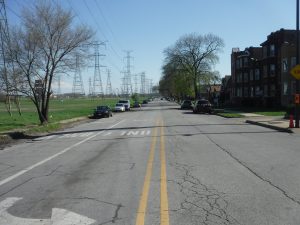
East Side’s Avenue A marks the Indiana (left)/ Illinois (right) border. (Photo by Igor Studenkov/for Chronicle Media)
Vasquez-Weber said she is excited about one development – the most recent plan for the Southworks site. Since the plant closed in 1992, there have been several plans to redevelop the site, but, there have been some modest improvements, none of the major ideas stuck. In January 2017, Barcelona Housing Systems, of Barcelona, Spain, unveiled a plan to build 12,000 homes on the site. According to the company’s website, it plans to take a cue from its home city, featuring “extensive green spaces, sustainable internal mobility, high use of renewable energies, common social areas, digital urban and community processes, urban vegetable gardens, etc.”
If the project is completed, it would have a direct impact on the East Side, since the south end of Southworks site is near the 92nd Street bridge.
In an official statement posted on the 10th Ward website, Garza wrote that she would fight for a community benefits agreement that would help her constituents.
Whatever happens, Vasquez-Weber said she knows where her priorities are.
“We’re not going to let [the East Side] go,” she said. “I grew up here, my kids grew up here, and I want my children’s children to live here.”
Free subscription to the digital edition of the Cook County Chronicle
Read the current issue of the Cook County Chronicle
— Chicago’s East Side Neighborhood looks out for its own —

